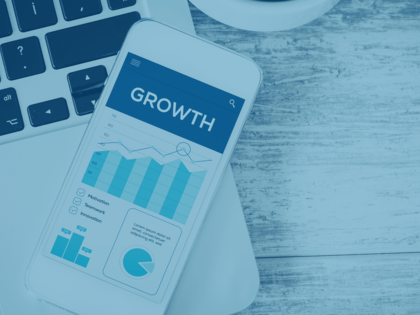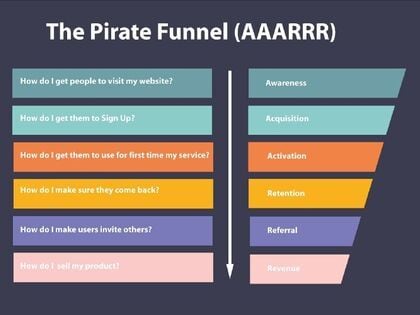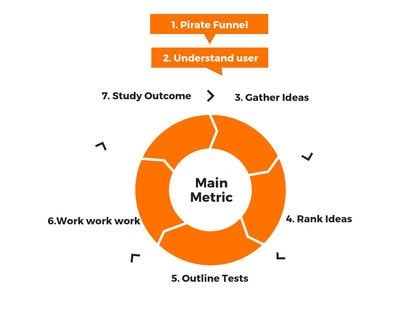Applying a Growth Mindset to Growth Marketing

Growth marketing is a relatively new field that’s been gaining a lot of traction recently. What started as a core tenet of early-stage startups has moved up the food chain to larger companies, and is now considered an important and highly sought-after component of the marketing strategy for organizations of all sizes.
Everybody is looking for a strong growth marketer, or at the very least, a way to transition their existing team towards having a growth mindset. So, how can having a growth mindset be leveraged to actually accelerate growth? Before diving into this question, we need to understand what “growth marketing” is.
What Is Growth Marketing?
An important first step to understanding growth marketing is to compare and contrast it with traditional “brand” marketing. There are plenty of nuances here, but it ultimately boils down to how a marketer approaches the funnel. Brand marketers traditionally focus on the top of the funnel—awareness and acquisition. Growth marketers, however, focus on the entire funnel.
Your job as a growth marketer is to drive growth across your organization in any way that you can, and this is done by growth hacking. Growth hacking is another buzzword that’s interrelated with growth marketing and the growth mindset, and is the driving force behind the lean startup methodology. It was created by early-stage startups to grow exponentially with tight budgets (Facebook and Airbnb, as examples).
Growth hacking is aggressive and lean, aiming to generate long-term, sustainable growth with as small a budget as possible, primarily by focusing on customer retention.

Mason Pelt provides a strong analogy to understand what growth hacking is about: “Imagine your business is a bucket and your leads are water. You don’t want to pour water into a leaky bucket; it’s a waste of money.”.
To bring Mason’s point home, traditional marketers ask “How can we increase the flow of water into our bucket?”, while growth hackers ask “How can we stop this bucket from leaking? Or, how can we get a new bucket that doesn’t leak?”. A combination of both is ideal, but it’s clear to see which one has a higher priority.
How Does a Growth Marketer Drive Growth?
Experimentation is the defining trait of growth. It’s impossible to understand what works and what doesn’t through intuition or experience alone. Growth marketers develop clear hypotheses, define experiments, and test their assumptions to ensure that their results are efficient and scalable.
Scalable results?
Yes, scalable! It’s one thing to understand that your marketing initiative is working, but to take it to the next level, you have to understand why it’s working. Your email campaign is performing well, but why? Is it the language you used? Perhaps you could drive 10-20% more growth by changing the tone of your copy. Is it the time of day? Maybe sending the email on a Thursday instead of a Monday will increase engagement.
Or, maybe you’re satisfied with the performance of your campaign. But what if LinkedIn outreach is better? You can read blogs like this one that tell you what works and what doesn’t, but there are so many extraneous variables at play here— how can a blog article have better insights into what resonates with your customers than your customers themselves.
This is the key reason why growth marketing is quickly becoming an industry standard. It’s a proven process for proven results.
Growth marketing gives you the confidence to invest more money into what’s working because you know it wasn’t luck. Similarly, it can give you the confidence to eliminate initiatives that you think are working when, in reality, it is actually luck. Furthermore, you can pick up on patterns that can apply to your other campaigns, saving time and money knowing that what you’re doing works because you’ve proven it.
But experiments are expensive!
If this thought has popped into your mind as you’ve read to this point, you’re not alone. Many marketers at small to medium-sized companies think that experimenting is out of their league. But, I’d argue that experimenting is even more important—and easier—the smaller the business is. After all, the growth mindset was conceived by startups that needed cheap growth to survive.
Being small can be a blessing in disguise. You’re agile and can pivot quickly and easily, which is a key way that the little guys have a competitive edge. Yes, experimentation can seem costly and wasteful at the surface, but the beauty of it is that you’re actually saving resources in the long run.
Curious about growth marketing?
An Experimentation Example
Here’s an example. Let’s assume you’re the proud owner of a lemonade stand in town. You’ve been having success selling lemonade for $1 per cup, but think you can do better. Your objective is to increase sales by 20%.
Your advertising budget is $100 for the year, and want to determine the most effective messaging to reach your sales target. Since you started selling lemonade, the sign has always said “Ice Cold Lemonade”. You know it works, but how well? You’ve created three other signs, and want to see which one has the most success by exchanging them every Sunday. Your experiment is as follows:
- "Ice Cold Lemonade"
- "Fresh-Squeezed Lemonade"
- "Delicious Lemonade"
- "Lemonade - $1"
You allocate $10 from your budget for each day. Here are your results:
- 50 cups sold (a typical day for you)
- 60 cups sold
- 40 cups sold
- 30 cups sold
Your “Fresh-Squeezed Lemonade” sign was a hit! You replace your old sign, and spend the remaining $60 on your new campaign, reaching your 20% sales goal. Now, I know this example has some holes in it. Nobody is spending $10 a day on signs for a lemonade stand, but that’s not the point.
By devoting 40% of your advertising budget to experimentation, you’ve successfully increased your sales by 20%! The “sunk-cost” of the experiment will be paid back in no time. This is not to say you should spend 40% of your advertising budget on experimentation, it will vary on a case-by-case basis.
The numbers are the least important thing to remember here. Instead, the key takeaway is that you have to give to get. This "giving" doesn't have to be expensive, either. Better yet, experimenting doesn’t have to cost money at all. Maybe you find a way to make these signs for free? If so, you’ve captured the essence of the lean startup methodology and, in turn, a growth mindset.
The key isn’t to invest as much as possible for growth, but instead to achieve as much growth as possible with the least amount of resources as possible.

G.R.O.W.S.-Process by Growth Tribe
This is a prime example of why experimentation is so important. What if you didn’t experiment and stuck with your traditional advertising strategy? Nothing! Your old strategy worked fine. It’s comfortable, and it’s not like it was performing poorly—it was the second most successful option, after all.
However, by sticking with your old strategy, you’re effectively missing out on 10 cups a day in sales. You may argue that this was an ideal case since your experiment successfully identified an optimization opportunity. What if they all failed? This answer depends on how you perceive “failure”. John Wanamaker, a pioneer in marketing said it brilliantly:
“Half the money I spend on advertising is wasted; the trouble is I don’t know which half.”
Oftentimes, your experiments will fail. More often than not, actually. But failure is learning. Growth marketing depends on incrementally whittling away at your ideas, your preconceptions, and your assumptions—even if they’re “correct”. Because who’s to say you can’t be more correct? As long as you’re getting something right, you’re doing well, and your success rate will increase over time.
The key takeaway here is this: A failed experiment eliminates a messaging point that you would probably use again, wasting ad spend. It’s fine if you waste money because once you learn which part is wasted, that’s how you start getting better.
How Experimenting Can Contribute to a Growth Mindset
Now that we’ve discussed why experimentation is a crucial component in growth marketing, how can it contribute to a “growth mindset”? There are three layers of depth that a marketer goes through while experimenting with a growth mindset:
1. Learning if what you’re doing has any effect in the first place. Are you noticing that your email campaign is improving conversion? It’s important to clearly establish your objectives and metrics at the onset. As a result, you’ll come prepared for the next growth layer—optimization.
Keep in mind that, although this upper-most layer is definitely important, you can’t stop here. That’s great that your email campaign is working! Your competitors are most likely doing the same thing. Unfortunately, this layer is useless on its own but is a powerful tool when preparing for optimization.
2. How do you get better? This layer is figuring out the right message, campaign, offer, etc. that you can take and run with, by leveraging the data and insights you’ve gathered from the previous layer. Maybe your push notification is the worst, most poorly put-together one out there. That’s okay because having a push notification is better than not having one at all. So, how do you come up with the best possible push notification?
3. Tailoring the message to your customers. This layer is where the money is, and is also the most difficult. Which push notification resonates with Mark better than Lucy? Personalization solutions give you the foundation to gather these insights. Once you get accustomed to running experiments, you’ll be able to create different ones for each persona. Tailoring your experiments to work in tandem with your personas will provide you with insights that traditional marketing isn’t capable of revealing.

The Experimental Framework, illustrated by Optimizely.
Conclusion
As a closing thought, it’s important to know that you don’t have to reinvent the wheel. The most successful growth hackers adopt past growth models and build upon them. It’s funny and fitting that growth marketers apply a growth mindset to growth marketing, but it’s true.
Regardless of the industry, experiment, product, or objective at hand, the growth mindset can be exchanged and applied with minimal modifications. There isn’t a patent on growth; nobody owns it. Instead, it’s a school of thought—a modus operandi—that anybody can adopt and apply.
This article is composed of elements taught by John McBride in the Growth Marketing Foundations section of the CXL Growth Marketing mini degree course.
Images sourced from Medium (https://medium.com/@tomascapponi/the-growth-marketing-tools-funnel-29-growth-tools-and-when-to-use-them-ed8378d91a5), Growth Tribe (https://growwithward.com/grows-process-growth-tribe/), and Optimizely (https://www.optimizely.com/optimization-glossary/ab-testing/).

